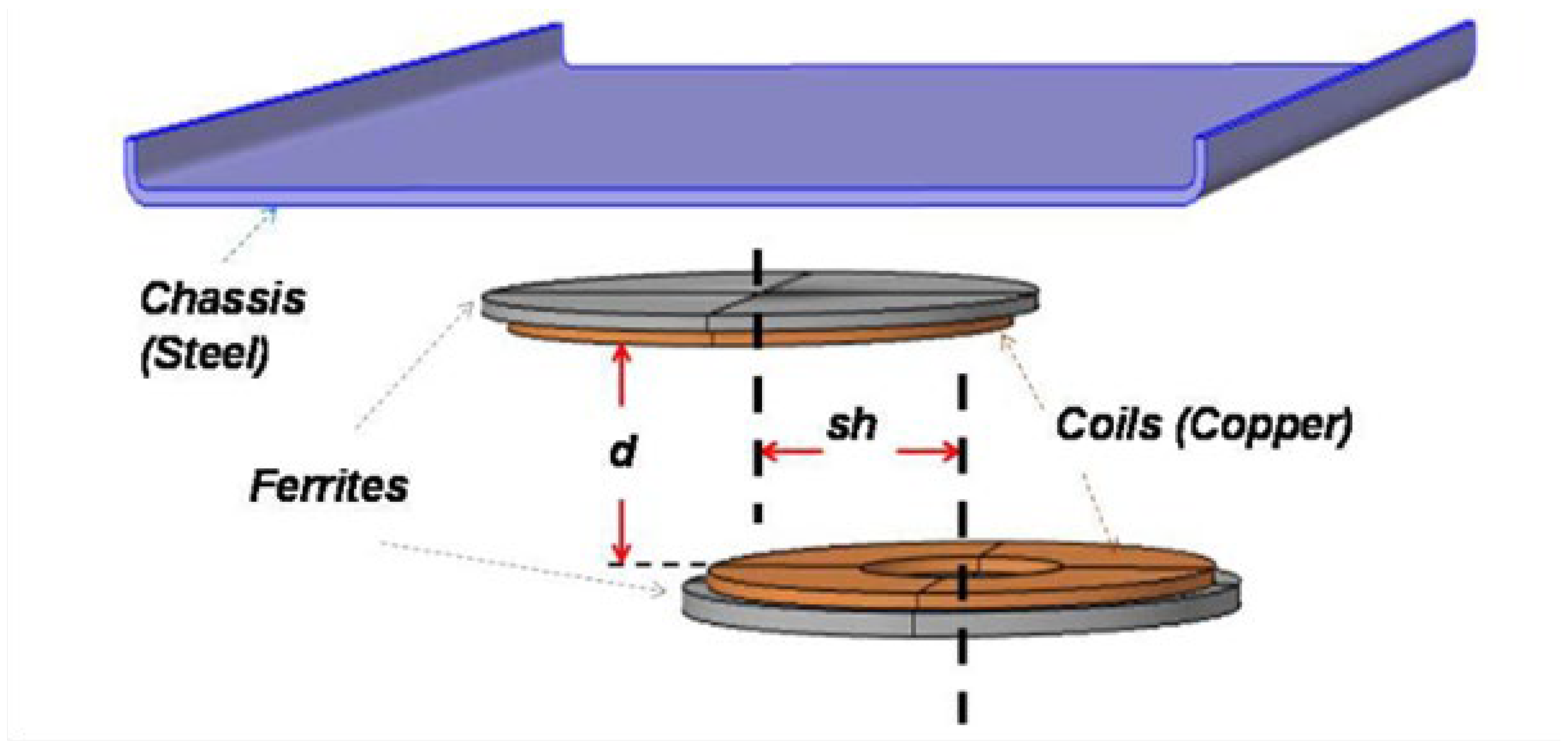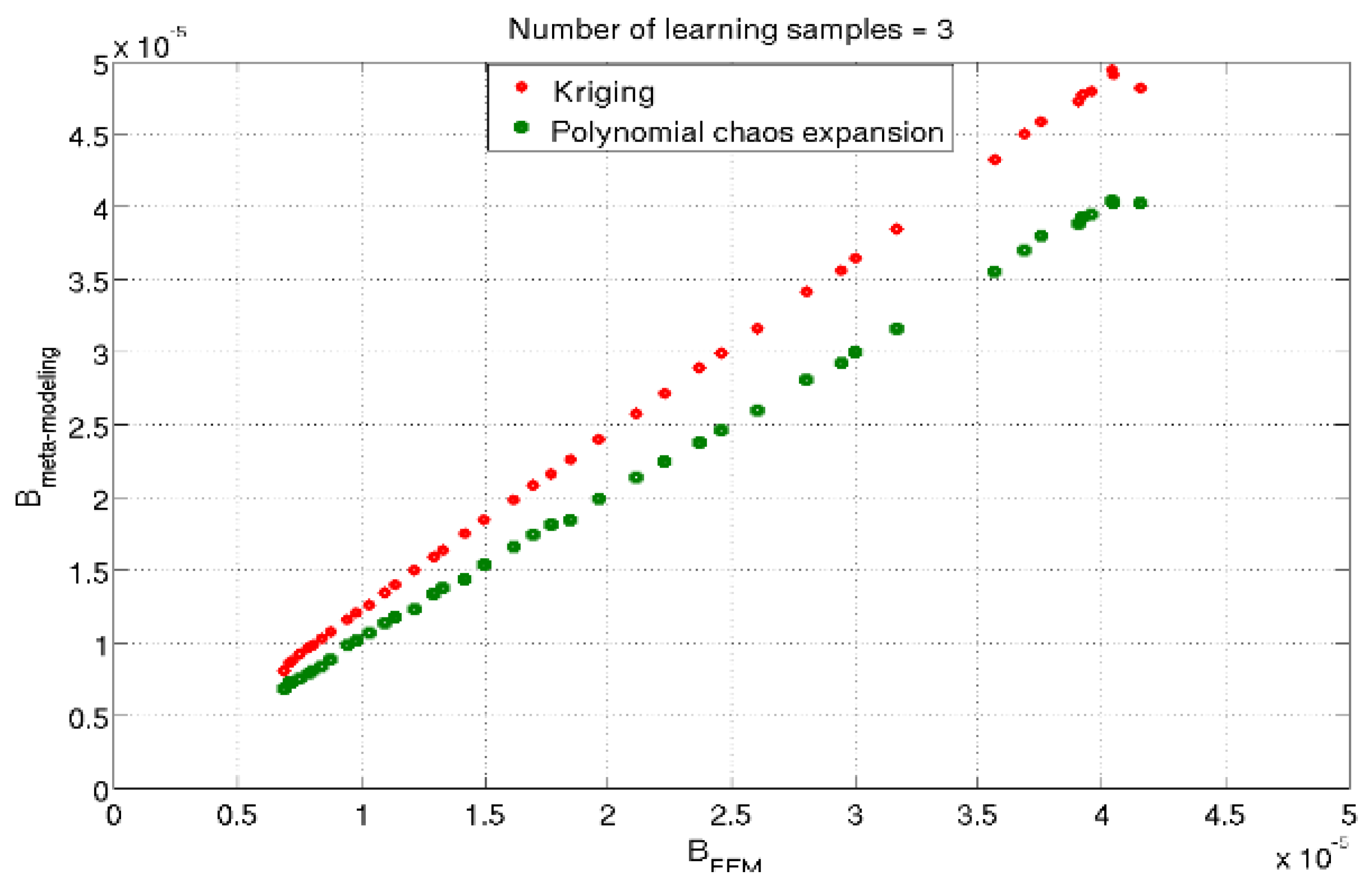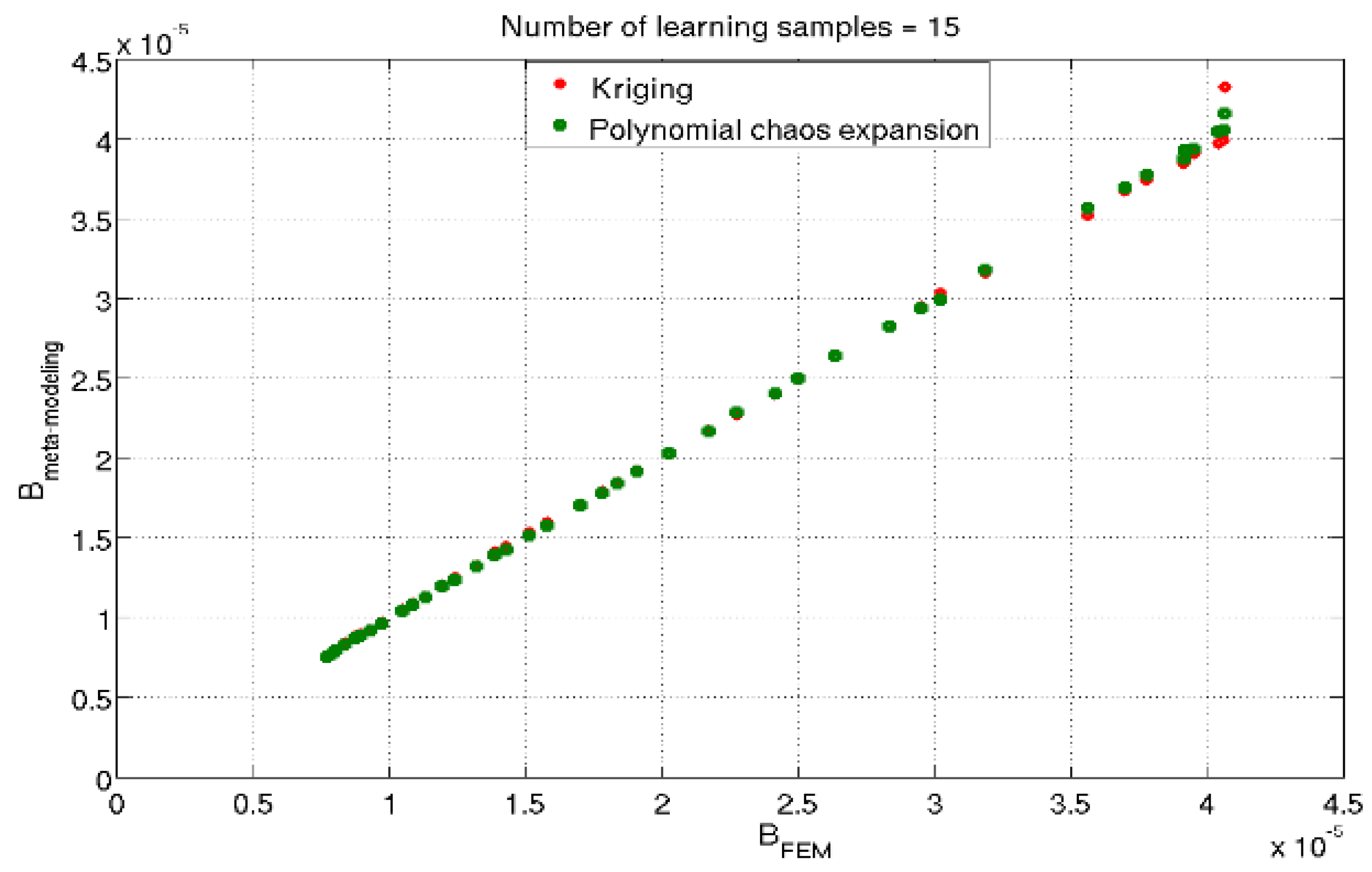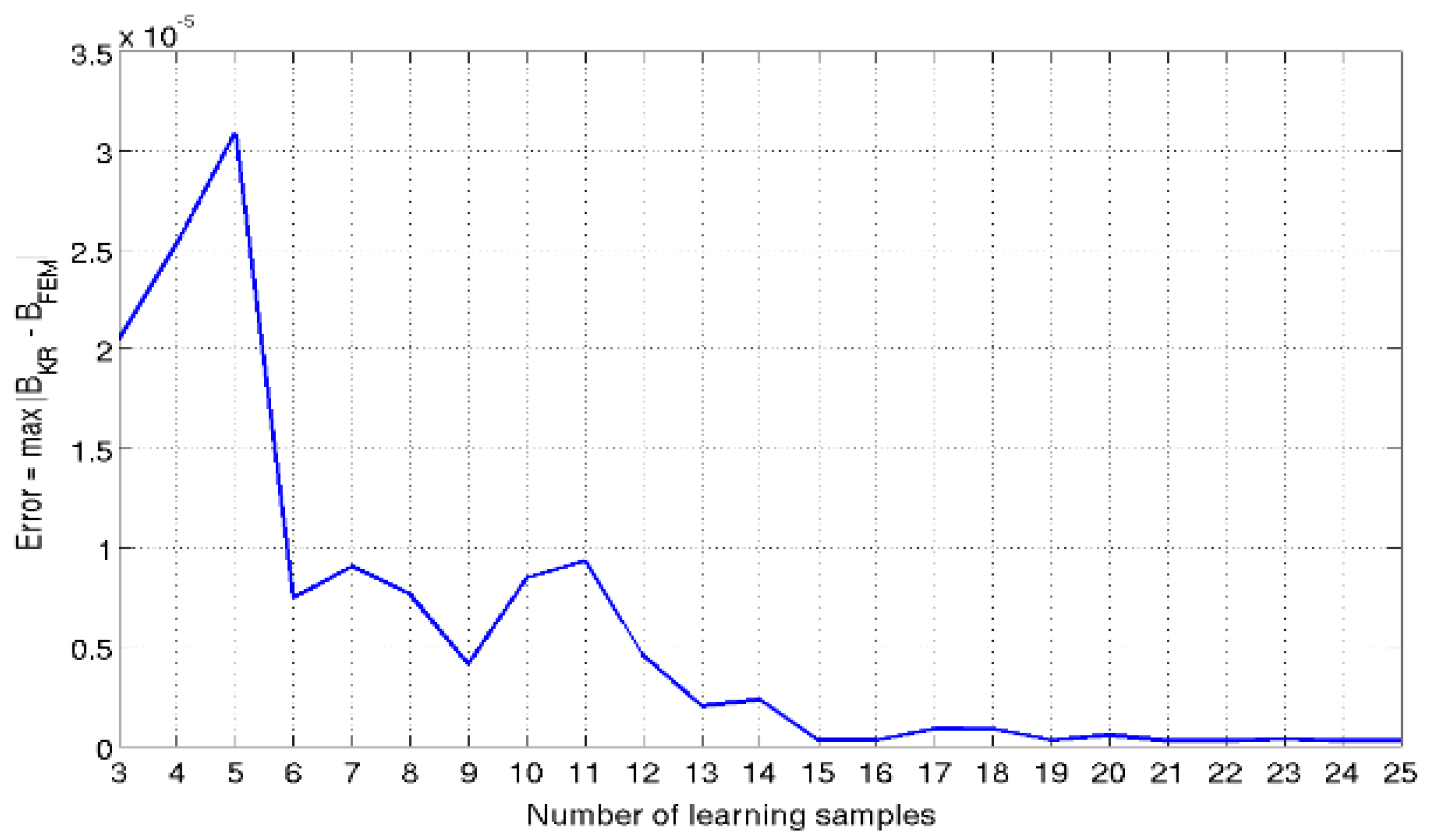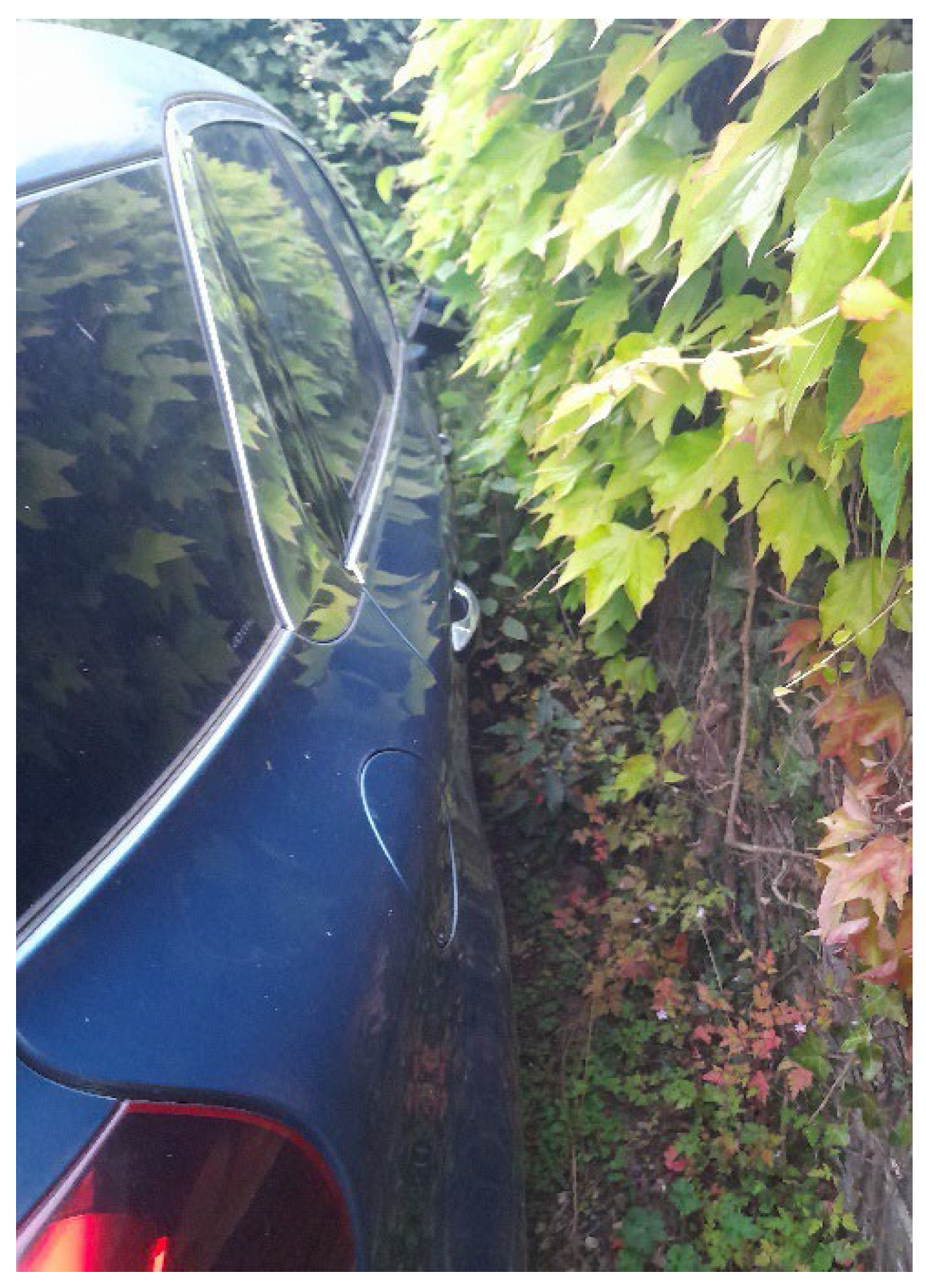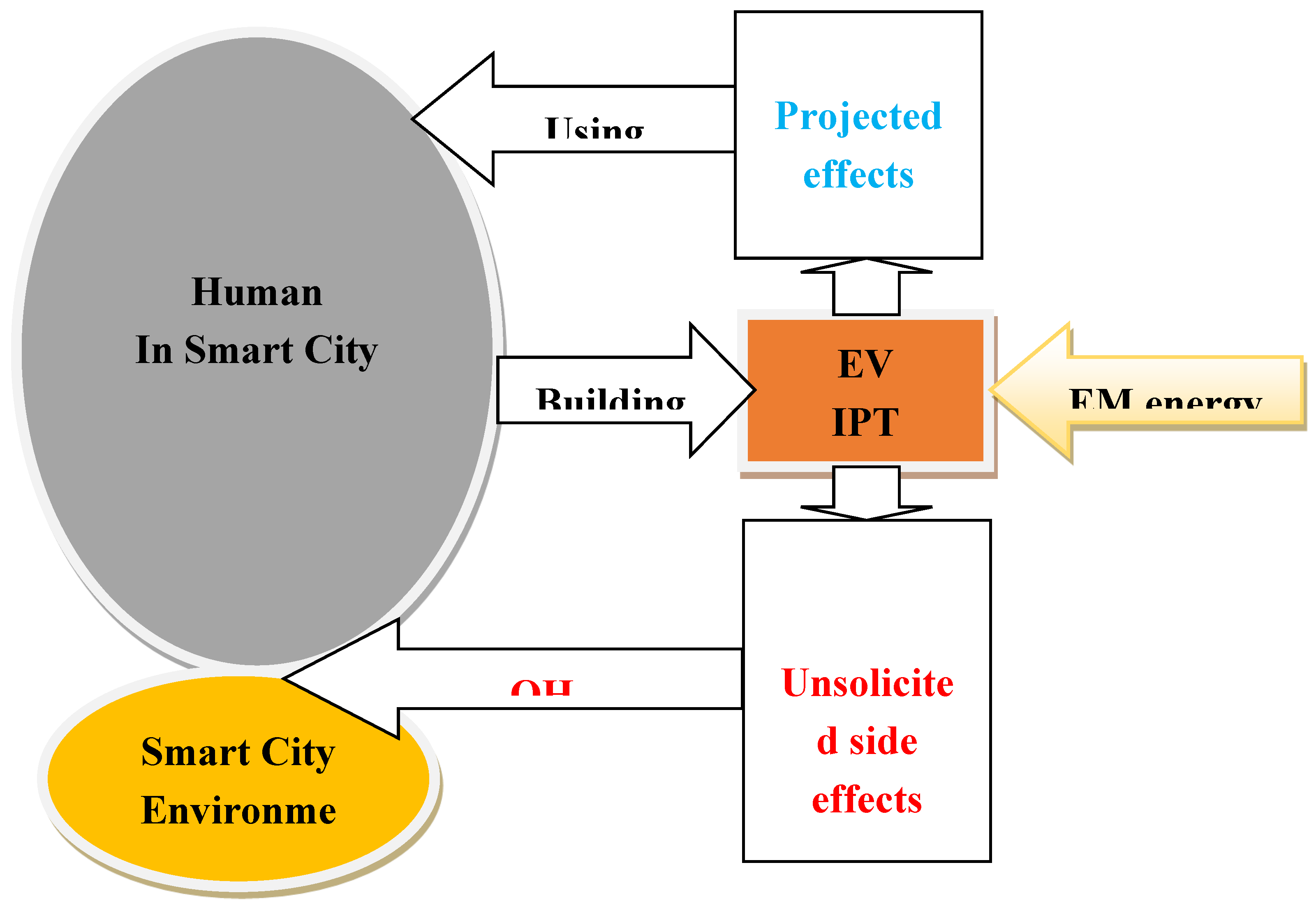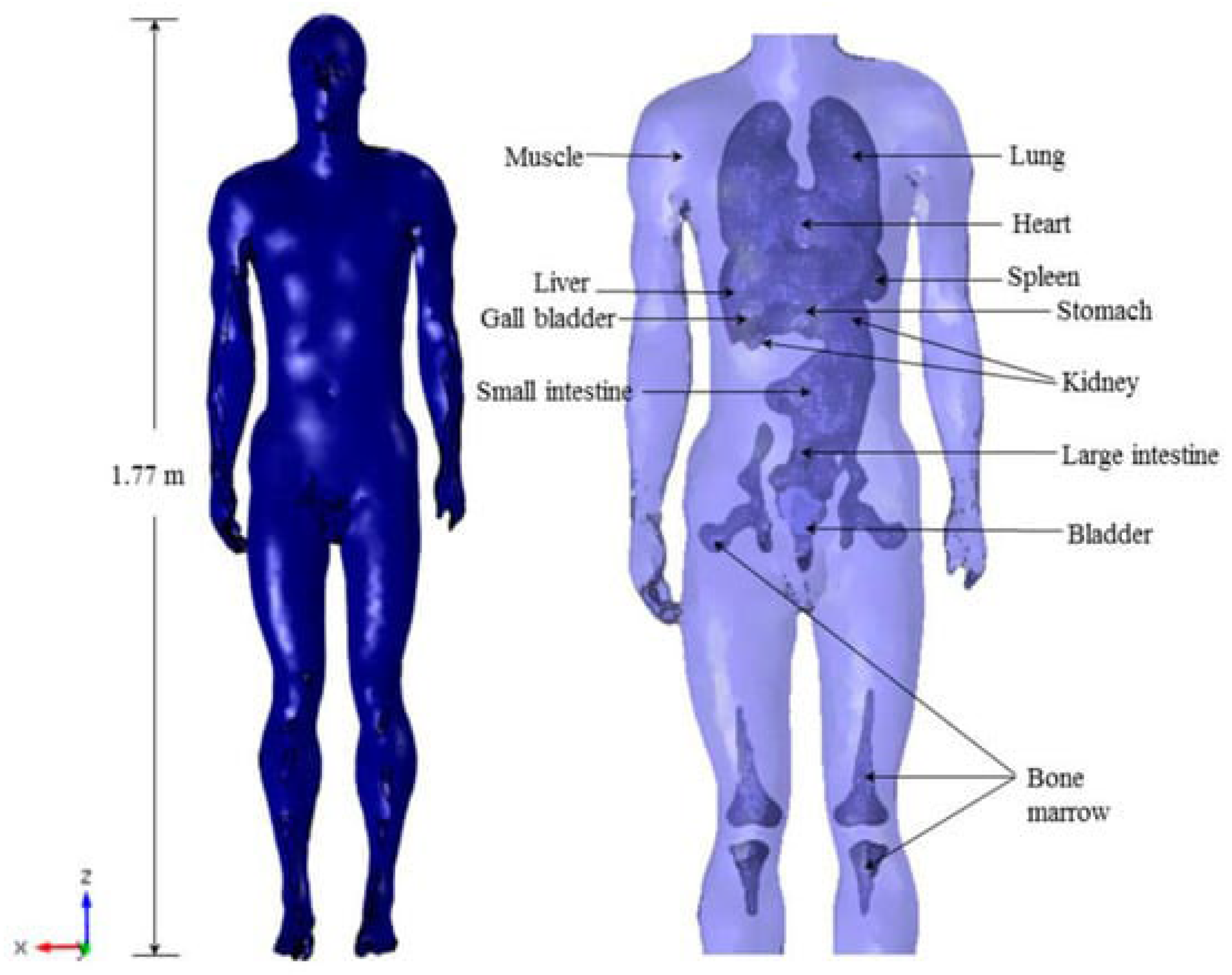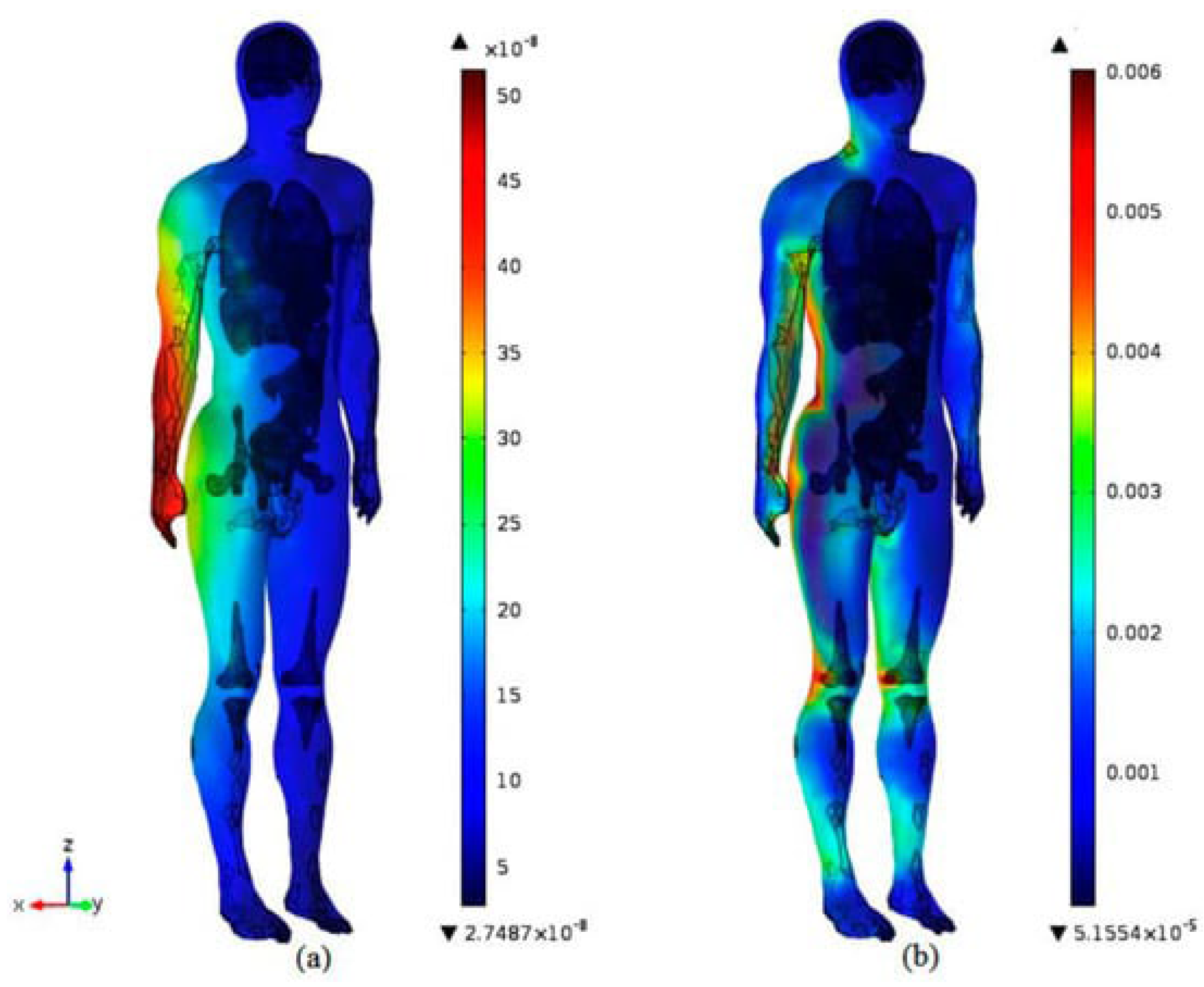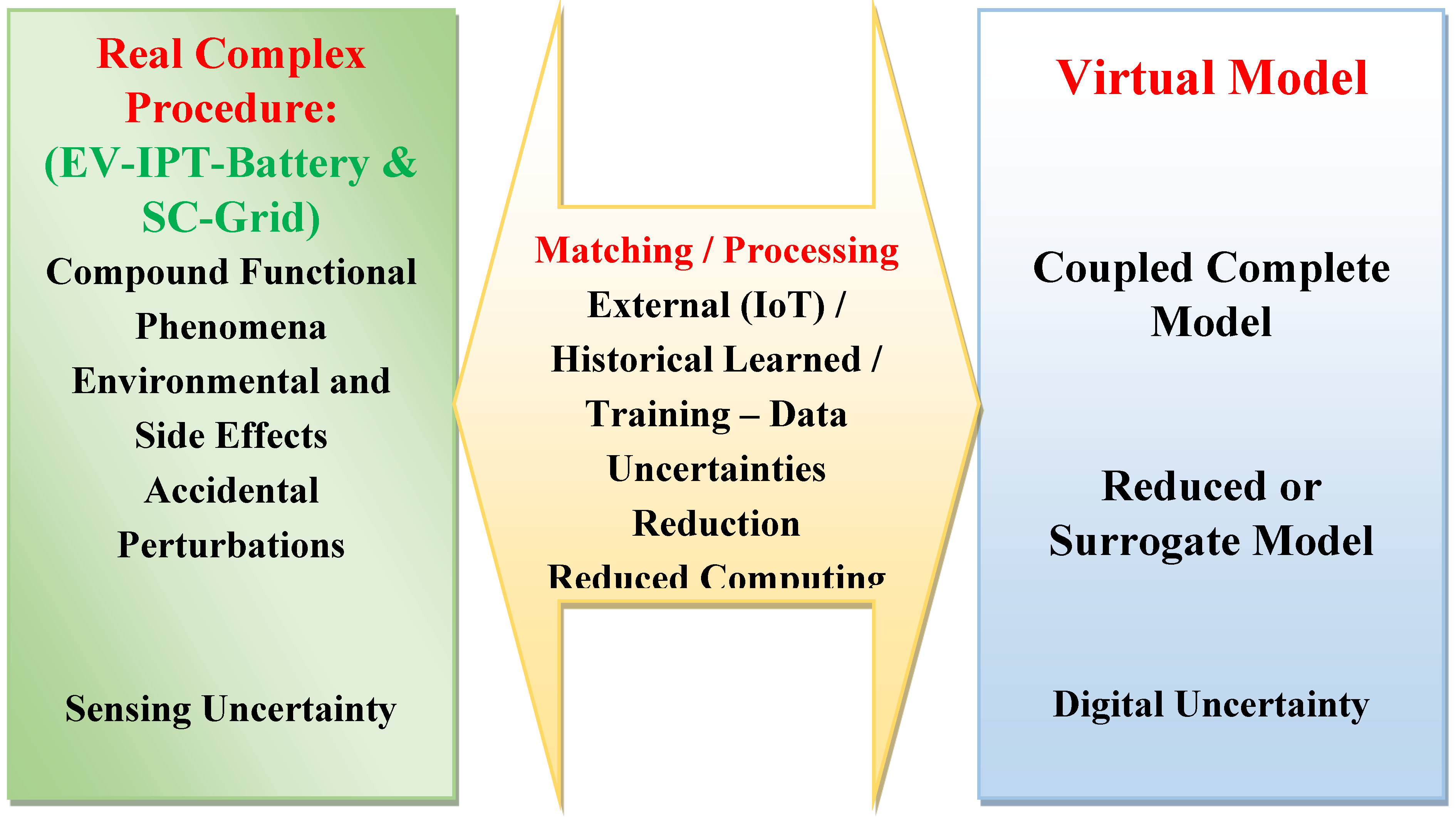1. Introduction
In modern society, various applications are developed for the daily well-being of humans involving comfort, health, safety, etc. These appliances operate using different sources of energy conversion. Such devices, in addition to offering the expected capabilities, produce undesirable side effects. An endless objective has remained at all times to improve the use of these resources. Thus, to enhance the expected results and reduce the undesirable side effects. These undesirable effects mainly disturb the health of people as well as that of wildlife, plants and biodiversity in general [
1]. Hence the notion of OH which includes, in the case of the urban context, the health of humans, animals, birds and plants, all endangered by the disturbances produced by human activities [
2,
3]. Furthermore, energy and environmental sustainability, which is one of the general issues raised, can ensure clean energy supply for human well-being. The management of well-being and nuisances related to the use of artificial tools is governed by a concept of RA in the conversion and use of this clean energy. These two methodologies concerning OH and RA would allow an adjusted use of energy for human well-being with reduced dangerous side effects for humans and biodiversity.
Among the devices operating with clean energies associated with human well-being, wireless electromagnetic (EM) energy devices occupy an important place. These are mainly WPT tools and everyday communication devices. These uses, in addition to their authentic functions, similar to those of common devices, have precisely their unexpected effects. Thus, they appear as unexpected suppliers of emitted EMFs, which are correlated with their wireless characteristic generating stray fields. Their effect is focused on the exposed object at an adjacent distance, e.g. a WPT or a mobile phone device [
4,
5,
6] and homogeneous in case of distant exposure, e.g. a mobile phone tower antenna [
7].
Reflecting the WPT tools, they mainly include four classes correlated with the object transfer strategy explicitly magnetic, electric, microwave and laser [
8]. The variations of these technologies are mainly related, as well as the transfer methodology used, to various factors. These are the amount of energy transmitted, the transmission distance, as well as the performance, sensitivity, constraints and complexity.
Regarding magnetic WPT, also called inductive power transfer (IPT), two concepts govern its operation, Ampere’s law of 1820 and Faraday’s rule of magnetic induction of 1831. These fundamentals later helped Nikola Tesla (1856-1943) to propose WPT in the 1890s [
9,
10,
11]. WPT tools were once originally intended to transport energy over long distances by means of microwave rays [
12,
13]. Similarly, the idea of WPT proposes the transmission of electrical energy in space from solar energy via satellite broadcasting for use on earth [
14,
15]. Only recently, adjacent-range near-field IPT tools have been widely exploited for charging batteries of various everyday devices such as mobile phones, household appliances, drones, and EVs [
16,
17,
18,
19,
20,
21,
22,
23,
24,
25,
26,
27]. A magnetic WPT or IPT refers to the contactless transfer of power from a source to a load across an air gap. Thus, an IPT scheme comprises a transmitter and a receiver coupled coils.
WPT technology is an important topic of current exploration in general electrical engineering sciences. Possible applications encompass a wide variety of fields, spanning mobility (EV), power generation, device battery charging, biomedical, etc. [
28,
29,
30,
31,
32,
33,
34]. The explanations for such a wide collection of uses are also numerous and diverse. For example, in a number of medical applications (implants, sensing tools, and pacemakers), WPT develops a safe load stripped of any contact or the need to operate under surgery. Moreover, in many industrial developments, the need for contactless power transmission for moving loads, marking the complications related to sliding connections or moving power cables, has motivated the expansion of contactless energy transfer (CET) links [
35].
This contribution aims to examine and explain the behaviors of IPT tools in the contexts of the OH approach containing smart cities biodiversity and the RA concept relating to better clean energy management. The current investigation is positioned in the context of the use of autonomous systems operating with decarbonized energy materialized by the replacement of thermal engine vehicles by EVs [
36,
37] equipped with electric energy storage batteries. Thus, air pollution is reduced and the biodiversity of smart cities is protected. The probable use of wireless charging of batteries should ensure that the new solution continues to protect this biodiversity. The two concepts of OH and RA will find their place in this context in the design and management of IPT tools.
In the following sections, we will first present an overview of the IPT tools embedded on EVs and their management for use in SC mobility. Then, the design and control of IPT devices with optimized energy consumption for human well-being and reduced unsafe side effects for humans and biodiversity will be addressed. Next, we will analyze the effects of EMF exposure radiated by IPT tools on living tissues in the SC context. The governing phenomena and their corresponding mathematical equations of the behavior of the IPT tool and its effects will then be informed and analyzed. The roles of OH and RA approaches in the SC context will then be analyzed. This involves the possible charging modes in SCs and their EMF exposure as well as the human in the SC circle of RA and OH approaches. Then, the procedures for protection against harmful consequences of EMF exposure will be discussed. The analyses pursued in the article are supported by examples of literature.
2. Overview of IPT Tools
The construction strategy of an IPT comprises its performances relayed to the input grid, output load, and their related efficiency. Such performances shape, the projected consequence relative to human comfort, the EMF drifting radiation involving human and biodiversity unsafety, the power factor, and the diverse losses affecting the grid and environmental sustainability. The IPT component accountable of wireless action is its inductive coupler transformer (ICT).
Figure 1 exemplifies a succinct schematic illustration of an ICT, of an IPT onboard of EV, composed of transmitter and receiver coils possessing inductances of L
1 and L
2, separated by an airgap representing a mutual inductance M
12. The two wings of the coupler are compensated by capacities C
1 and C
2. These two roles, power transfer and capacitive compensation, figure the process of the IPT tool. The first action that linked to the ICT permits the wireless transfer through the magnetic induction ensuring a galvanic split of the power source and the battery load. The second action that associated to the capacitive compensations lets the power electronics connected to ICT (with the source and the load) to function at resonance that optimizing the process. Actually, the ICT airgap size is relatively important and hence its two coils coupling is weak. Thus, to transmit the required power, a significant reactive power must be absorbed, hence the essential use of resonant capacitive compensation components [
23,
24,
25,
26,
38,
39,
40,
41,
42,
43,
44,
45] on both sides of the ICT to guarantee reliable efficiency. Reactive power compensation can use several topologies (series and parallel) on both sides of ICT, depending on the nature of the load, such as SS, SP, PS, PP, etc. [
23,
39]. The SS (Series-Series) compensation topology is an economical option [
23,
45]. To increase the power transfer efficiency, which is related to a better coupling coefficient, magnetic ferrite sheets are generally used covering the two coils of the ICT.
The ICT including its magnetic ferrite sheets is incorporated in the IPT between the input AC grid via a stage of filtered constant-variable conversion of frequency and voltage, and the battery load via a stage of filtered AC-DC conversion. Note that the IPT power regulation is achieved by monitoring the ICT input voltage and frequency.
Figure 2, shows a schematic representation of a static IPT charging device of EV battery. This include, the AC grid, grid frequency AC/DC converter, filter, adjusted voltage and high frequency DC/AC inverter, ICT, AC/DC load converter, filter and load.
The RA sustainable design and control of IPT onboard of EVs in SC context could be accomplished within the building of the ICT (coils and ferrites), the compensation features, the involved static convertors and filters. The enhancement could involve losses reduction, superior power factor, bettered coupling and lowered stray field radiation, which impacts OH approach. Such design and control are discussed in the next section.
3. Design and Control of IPT Batteries Charging
The OH and RA approaches are closely related to the IPT design and load (battery) scheduling control. The design involving sustainable optimization of the IPT could be realized for the coil and ferrite structures of the ICT, the static converters and inverters involved, the compensation components needed for resonant operation and the filters used. Such optimization aims at improving the efficiency and power factor on one side and a better coupling of the ICT with reduced parasitic radiation on the other side. These two sides of the optimization are mainly related to RA and OH approaches and illustrate their junction. Many works have been published on the topic of optimization of IPT components; see for example for improved performances [
38,
39,
40,
41,
42,
43,
44,
45,
46] and for reduced radiation effects [
47,
48,
49]. Load scheduling control enables sustainability linked to the use of clean (carbon-free) energy and economical pricing; see for example [
50]. In fact, EM energy is considered strictly clean if it comes from a clean energy conversion facility. Since the different energy conversion means are connected to the same grid (for the moment), intelligent load planning allows the use of renewable or other decarbonized energies (hydro or nuclear power plants); see for example [
51,
52]. This problem would disappear when the grid would contain only clean energy conversion deliveries.
4. Biological Effects on Living Tissues Due to EMF Radiation from IPT
The interaction of EMFs with a substance resulting from field radiation causes a dissipation of EM energy in the substance. Various effects are occasioned in the matter due to such dissipation, generally correlated to the frequency range of the EMF.
EMF waves display an extensive frequency range embracing non-ionizing (103–1014 Hz) and ionizing (1015–1022 Hz) extents. The non-ionizing waves are utilized in daily human activities like IPT devices. The mainly common consequence of such exposure especially in the range (105–1014 Hz), which comprise utmost IPT uses is a temperature rise subject to the features of radiated field and the threatened matter. The exposure characteristics include the strength, the frequency, the nature and the interval of exposure field. Those of matter relay to its physical belongings including electric, magnetic, dielectric, mechanic and heat occurrences. The mentioned customary thermal effect on matter normally arises for lessened radiation due to normalized protection, moderate exposure time and relatively distant from the source. It is worth noting that living tissues exposed to disproportionate field strengths, frequencies or period could endure irremediable molecular disorder that can invigorate nerves, muscles and generally excitable organizations.
As mentioned above, the biological effects (BEs) due to IPT emitted EMF are commonly thermal due to tissue energy dissipation. These concern tissues of humans, fauna and flora. In such circumstances, an instant BE caused by high frequency radiation would end in a swell in inside tissue temperature. The regular heating persistence of these living tissues is principally fitted to outer heating of the matter for instance sun exposure. In this circumstance, heat is slowly spread by conduction and convection within the tissues, which ordinarily fluid perfused permitting correct functioning. Contrariwise, focused heating deepest the tissues, specifically those weakly irrigated or unwell immersed by blood or sap, could be dangerous contingent to the physiognomies of the radiation field and the tissues. Different unsafe outcomes of radiated EMF of IPT could be tested by evaluation alongside thresholds established by standards taking into account the tissues nature, the functional and conditions of exposure; see e.g. for human and fauna [
53,
54] and for plants [
55,
56]. Regarding the frequency weight in exposure, it should be noted that, in near field applications like IPT for EVs the used frequencies are relatively low while high frequencies are normally used for far field applications like microwave (MW) IPT tools intended to transmit power through free space. Both IPT types implicate EMF radiation however with unlike BEs. In fact, strengthen field and frequency produce more severe effect due to deeper internal impact in tissues. Obviously, reducing near field IPT frequency could reduce the radiation effects, however will worsen the performance of the tool.
5. Phenomena and Equations Governing IPT and its EMF Radiation Effects
Computation and data are now an integral part of almost every industrial sector. In the automotive industry, mathematical models increasingly compete in terms of functionality, safety, automation and eco-design [
57]. The phenomena governing the design of IPT are related to EM and electric circuit domains. As well, the phenomena involved in the side effects of IPT radiated EMF are related to EM and heat transfer (HT) occurrences. In fact, the interaction of EMFs radiated by IPTs with substances produces undesirable thermal BEs, which are governed by the coupled EM and HT phenomena via the EM dissipated power (P
d) in these substances. In case of EMF exposure of living tissues, a bio heat (BH) phenomenon will govern the temperature rise originated by a heat source P
d. The different mentioned phenomena are ruled by corresponding mathematical equations, which are presented in the next sections.
5.1. Governing Equations
Based on the Maxwell’s microscopic local behavior, the differential form of the general EMF 4 equations [
58] given by:
The HT equation in its differential form is given by:
In the case of EMF exposure (radiation) of living tissues, the EMF harmonic fields, the BH and heat source P
d equations are given as follows:
In the above (1-11) equations, H and E are the vectors of the magnetic and electric fields in A/m and V/m, B and D are the vectors of the magnetic and electric inductions in T and C/m2, A and V are the magnetic vector and electric scalar potentials in W/m and volt. J and Je are the vectors of the total and source current densities in A/m2, σ is the electric conductivity in S/m, ρe is the volume density of electric charges in C/m3, and ω is the angular frequency = 2πf, f is the frequency in Hz of the exciting EMF. The symbol ∇ is a vector of partial derivative operators. The symbol ∂t is the operator of partial time derivative. The magnetic and electric comportment laws respectively between B/H and D/E are represented by the permeability μ and the permittivity ε in H/m and F/m. The parameters: ε″ is the imaginary part of the complex permittivity of the absorbing material and ρ is the material density in kg/m3. E is the absolute peak value of the electric field strength in V/m, c is the specific heat of the substance in J/(kg °C), k is thermal conductivity in W/ (m∙ °C), and T is the substance temperature in °C. The power dissipation in W/m3 given by equation (11) relates to foremost dielectric heating of EMF energy loss. Notice that the imaginary part ε″ of the (frequency-dependent) permittivity ε is a measure for the ability of a dielectric material to convert EMF energy into heat. The volume density of power dissipations given by equation (11) will be used in the coupling of EMF and BH equations. In the case of living tissues, we consider a self-tissue heat source Pt, convective heat transfer via irrigating fluid of tissue, and external heat source related to the EMF exposure Pd. Pt and Pd are heat sources in W/m3, Tf and T are respectively the fluid temperature and the local temperature of tissue in °C, and cf, ρf, pf are respectively fluid, specific heat in J/(kg °C), density in kg/m3, perfusion rate in 1/s.
It should be noted that the source term in the EMF equations is the excitation current density Je = σ Ee = j ω De = j ω ε Ee. In addition, the specific absorption rate (SAR) in dielectric materials (biological tissues) is equal to Pd /ρ in W/kg.
Note that equation (11) relays to bio-heat tissues considering the EMF exposure. This expression is analogous to the Penne’s bio-heat equation [
59,
60,
61,
62] related to animal living tissues including convective heat transfer in blood. The sap fluid in plant plays the role of animal blood. Besides, Phloems and Xylems enclosing sap act the task of veins and arteries inclosing blood. In the Penne’s bio-heat, equation the term P
t in (11) is related to animal metabolic heat and corresponds to internal heat in plant tissues. In addition, the last term in (11) that acting for convection fluid heat transfer, relate to animal blood or plant sap.
Considering the design and optimization of ICT discussed in
section 3, based on a better coupling coefficient k according to:
The two resonant circuits for e.g. SS compensation of the transmitter and receiver are tuned at the resonant frequency ω
o :
The structure of the ICT coupler, schematized in
figure 1, is presented in
figure 3. It comprises the transmitter coil (on the ground), the receiver coil (on the EV bottom) and two magnetic ferrites plates that entirely covering the two coils. In addition, the figure includes a steel plate representing the EV chassis. The two ICT coils with their ferrites (pads) are separated by an air gap of distance (d), and of coil axes shift (sh).
The EM analysis of the ICT behavior is related to equations (6-9 and 12, 13) where the EM domain (6-9) will be coupled to the circuit domain via a general circuit equation under the form:
In (14) v is the source voltage, i the circuit current, r the total circuit resistance, l a linear inductance, C a capacitance, ᴕ a non-linear voltage drop (e.g. a semiconductor component) in the electrical circuit and Ψ the flux linkage. The equations characterizing the EM and circuit domains to be solved are therefore (6-9, 14).
5.2. Numerical Solution of EMF, BH and Circuit Equations
The numerical solution of the different equations relative to the EM, BH and electric circuit domains, respectively (6-9), (11) and (14) should account for different features of modeled structures. These are geometrical complexity, matter inhomogeneity, variables nonlinear behaviors and interdependence of domains. Fulfilling such features imposes a matter local solution indicating the use of discretized 3D methods as finite elements (FEM) or equivalent methods [
63,
64,
65,
66,
67,
68,
69,
70,
71,
72] associated to suitable equations coupling strategies.
Considering the prediction of tissue BEs the involved equations (6-11) presented in the last section would be solved in a coupled manner. In such circumstances, the EMF and BH discretized equations would be weakly coupled due to the distant values of their time constants [
59,
60,
61]. Thus, performing an iterative procedure gives the local distributions in the tissue of the fields induced local (i) values
Ei,
Bi, and
Ji, and hence P
di, SAR
i, and ΔT
i. The implicated tissue parameters are ε, P
t, c
f, ρ
f, p
f, etc., which could be measured or found in literature [
73,
74,
75,
76].
Regarding the IPT design, the governing equations are related to the EM domain (6-9) and an electric circuit domain (14), which needs a coupled equations solution. Generally, the coupling of EM and electric circuits needs simultaneous strong coupling solution of the equations due to non-linearity of variable behaviors and closeness of the magnetic and electric time constants [
77].
5.3. Dedicated Models Adaptations
These latest numerical solutions and equations coupling strategies permit an accurate evaluation of the concerned phenomena. However, the class of needed evaluation depends on the dedicated use and therefore adaptations of the formalism are sometimes necessary to achieve the committed task. This could involve in many cases a recurrent procedure that needs to be executed in a repeated manner. In this case, mathematical models and processing tools are used for simulation, design, optimization and reliability analysis.
In the initial design of the WPT structure, a full coupled model (EM - electrical circuit) (6-9, 14 associated with 12, 13) seems necessary. Similarly, in the prediction of possible adverse effects on living tissues, a full coupled model (EM - BH) (6-11) seems indispensable. Conversely, in situations where computational time could be a constraint, such as repetitive adaptive optimization approaches or online control procedures, the full-coupled models mentioned above would be penalizing.
Numerical solutions of complex structures could be difficult due to the complex coupled equations involved [
77]. Therefore, in the case of structural design, approximate approaches are needed to reduce the model and perform sensitivity analysis. Sensitivity analysis is a phase of the design that allows studying the variation of the calculated quantities according to variations in the inputs and parameters of the model. Reducing a model consists of accelerating its resolution while degrading the precision as little as possible [
78]. The difficulty is therefore often to find the limit between saving time and deteriorating precision. The numerical experimental plans make it possible to identify a reduced model for optimization purposes. The functions to be identified are generally imposed (radial basis functions, Kriging functions, Bayesian network, etc.), and the data used for identification can come from simulation results [
79].
In the context of optimization, a strong constraint is to maintain the dependence between the model outputs and the parameters to be dimensioned. The reduction objective may also come from the need to couple the model to other models, for system-level simulation purposes. In this case, numerical processing can be directly applied to the fine model, resulting in the loss of model dependence on physical and geometric parameters. For example, for a dynamic system, reduction often consists of reducing the order of the system, that is, the number of state variables. This approach can be automated by numerical analysis by neglecting the lowest time constants. After applying several algorithms to a model, it is appropriate to approach multi-model optimization and in particular multi-level modeling optimization. The main idea comes from the observation that a fine model takes a long time to calculate and much longer to optimize. A reduced model (surrogate model) is then substituted [
80,
81] for the fine model to carry out a pre-sizing. The solution is then used to reduce the fine optimization space of the model.
In the analysis of the compliance of IPT systems with international standards regarding living tissues exposure mentioned in
section 4, one can use stochastic non-intrusive methods (Kriging, Polynomial Chaos, etc.) [
79,
82] that use 3-D FEM computations with a limited set of realizations (learning samples). In this context, Kriging and Polynomial chaos expansions provided efficient meta-models to take into account uncertainties of different physical or geometrical parameters [
83].
5.4. Example on Meta-Model Features
In [
83] an optimization problem considering material and geometrical features, predictions of radiated magnetic field have been obtained from two non-intrusive stochastic models for a given WPT system for EV. To illustrate the precision of these meta-models and the gain in computation time,
figure 4 and
figure 5 illustrate the relation of the fields obtained from the 2 meta-models related to the FEM computations respectively for 3 and 15 learning samples of 30 all samples computations and
figure 6 shows the error function of the number of these samples. Concerning the computation time required for the meta-models, whatsoever meta-model and learning samples number, the computation time rests insignificant related to all the samples FEM calculation.
The results given in
figure 4,
figure 5 and
figure 6 show the efficacy of using meta-models for repetitive possible optimization designs though compliances of IPT with standards. Note that reduced models are also well adapted in control and online monitoring of IPT systems (see
section 8).
6. OH and RA Approaches in SC Context
IPT wireless charging of electric vehicles is a SC-friendly solution, relevant for shared and autonomous EVs, public transport (buses, trams and ships), medium-duty delivery trucks, drones, etc. It can be static charging (in infrastructure stations or at home for personal EVs) or dynamic charging (electric roads). The latter can be wireless via IPT battery charging or connected to the grid via a sliding contact, used in particular for public transport. In addition, there is a third intermittent charging mode, which could be discontinuous electric roads or split static charging points.
6.1. Charging Modes Possessions
A full static IPT charging mode corresponds to a limited range over a distance; it requires high battery storage and is well suited for personal EVs and taxis. A mixed dynamic-fixed IPT charging mode is mainly suited for long-distance highways and requires less battery storage than the latter case. A full dynamic mode corresponds in general to a fixed trajectory; it does not require battery storage and is well suited for electric buses and trams connected by sliding contact to the grid. A discontinuous dynamic mode corresponds to a partially fixed trajectory, requires low battery storage and is well suited for buses with particular trajectories or areas including portions with difficult grid connection infrastructures. The mentioned mode using remote static charging points corresponds to electric buses charging at their stops for which the battery storage depends on the number of stops, the distance and the static duration. All the latter mentioned IPT charging modes require safety precautions against EMF exposure (see
section 7).
6.2. RA and OH Approaches of IPT Management in SCs
For all the different charging modes mentioned above, both RA and OH approaches aim at the same goals of eco-design, clean energy usage, minimization of losses, reduction of adverse effects on living tissues, and assessment and protection of biodiversity safety. Moreover, energy management between the grid and the EV could help RA; thus, control algorithms can be used for both grid-to-vehicle (G2V) and vehicle-to-grid (V2G) operating modes [
84,
85]. Furthermore, it is necessary to ensure interconnection and interoperability between various wireless charging devices [
26,
86]. Moreover, providing a configurable charging profile enables improved RA [
87]. Moreover, connectivity and autonomous driving capability will make EVs (cars and trucks) much safer [
88].
6.3. EMF Exposure and Charging Modes
The stray EMFs of ICTs are highly dependent on the relative positions of the ICT coils in 3D geometry and are therefore affected by the charging mode, static or dynamic. The effects of these fields on living tissues are associated with the location of these tissues relative to the position of the ICT, which is different for static and dynamic modes. In dynamic charging mode, the stray fields are variable and take minimum and maximum values depending on the position of the ICT receiver coil in the bottom of the EV relative to the ICT transmitter coil on the ground. In this case, the affected living tissues are mainly those in the passenger compartment inside the EV. In the case of static charging mode, the passenger compartment is normally empty. On the other hand, for such a mode, living tissues, which can be humans, animals, birds or plants, located outside the EV in the vicinity of the ICT under its bottom, could be affected by exposure to the stray fields. Open space charging is often practiced for personal EVs at home and remote static points correspond to electric buses charging at their stops. As mentioned in
Section 6.1, exposure safety precautions are necessary with respect to these charging modes.
Figure 7 illustrates examples of such threatening situations.
6.4. Human in the SC Circle of RA and OH Approaches
This section summarizes the role of humans in the SC environment in terms of their contribution to the construction of the IPT and the choice of the quality of the energy used. Moreover, how they can benefit from its expected results as well as how they can suffer from its possible side effects.
Figure 8 illustrates this causal approach of the design and energy expended in EV-IPT, its expected utility and its unsolicited effects on human and his environment.
The present work focussed on the approach of RA through the design and use of clean energy in IPT and on the concept of OH by counting whole SC biodiversity involving humans, animal birds and plants in the controlling of adverse EMF exposure influences, which comprise their assessment and monitoring.
Figure 9 summarizes such strategy.
Certainly, the analyses of IPT tools conveyed in this work could be classified in two interconnected actions of RA and OH approaches. The enhanced design of IPT devices using EM clean energy devoted to superior performing and diminished stray fields belong to RA action. On the other hand, the evaluation and control of adverse BE for biodiversity security belong to OH action.
Figure 9 shows an illustration of such interaction of these two actions.
7. Safeguard against the Unsafe Effects in SC Environment
As mentioned formerly, the enhanced design of an IPT device aims to strengthen the expected power transfer and decrease unwanted EMF radiation that might disturb not only humans but too further associated environmental biodiversity. Such aims could be attained over IPT optimization and monitoring. The reduction of near EMF (target close to ICT) disorders is a difficult mission particularly in the circumstance of sources associated to wireless devices. Actually, for straight sources emitting EMFs, target guard could be accomplished via shielding of the source, the target, or both. Note that in case of EV, ICT (source) shielding (in 3D geometry) is very complicated due to its structure and position, partially in the bottom of EV and in the ground. This difficulty is stronger for larger or twisted coils airgap.
7.1. Protection in Dynamic and Static Charging Modes
As mentioned above, reducing the IPT stray field can be difficult. However, shielding the upper part of the ICT, including the passenger compartment, is an easy task using shields of appropriate shape and material [
89,
90]. Such a technique is mainly used in case of presence of people or animals inside the EV such as in dynamic charging mode or buses with distant static charging points. In the case of static charging mode in an open space, shielding may be necessary only to protect electronic instruments. However, the field radiated by the ICT outside the EV under and around its bottom can affect all living tissues. This effect is more significant for larger air gaps or greater misalignment of the coil axes corresponding respectively to the distances d or sh in
Figure 3. Since these parameters are difficult to control, any presence under or near the bottom of the EV should be avoided, especially for a significant duration. In the case of personal EV charging at home, only closed spaces or areas encircled in an open space, thus avoiding the presence of humans, animals, birds, plants, etc. near the ICT would be completely safe. Additionally, installing ICT away from the bus entrance and passenger waiting area is necessary for public safety in the case of remote static charging points.
7.2. Control of BEs in Living Tissues
The situations described above could be verified and controlled by routines given in
section 5 checking field values in living tissues compared to thresholds established by universal standards [
53,
54,
55,
56]. In all charging modes, the above-mentioned routines should include the specific living tissue geometry and matter properties. Assessment of living tissue exposure to EMFs requires approaches based on 3D calculations to solve the EM problem (6 - 9) containing representations of the ICT system, the vehicle and the living tissue object (in the vehicle or located nearby).
7.3. Living Tissues Models
The most significant characteristics governing the recognition of such models are the reliability of the physico-biological belongings, the realistic state and the consistency with the numerical methodology used. Different living tissue models and matter characteristics could be found in literature, e.g. for human tissues [
73,
74,
75,
76,
91,
92]. For example in human case,
Figure 10 shows a structural model of the body and its various organs and tissues.
7.4. Example of Exposure BEs
An illustrative example of ICT radiation exposure relating to the case of a human body positioned horizontally on the ground next to an EV under static charging mode is given here [
59].
Figure 11 shows the distributions of induced fields in the body due to exposure to ICT. The used human body for computations corresponds to the high-resolution human anatomical model, compatible with the numerical approach used, presented in
Figure 10.
The corresponding results in this case were in agreement with international safety guidelines (27 μT for magnetic induction B and 4.05 V/ m for the electric field E).
8. Discussion
In the above analyses, OH and RA approaches have been widely discussed regarding their roles in the design and control of IPTs integrated in EVs for the SC environment. These two approaches are more generally involved or could be extended to more interesting situations.
Interdependence in OH approach and beyond: As defined earlier the OH approach is a combined, fusing approach that targets to sustainably weigh and enhance the healthiness of man, animals (domestic and wild), plants and the larger environment (containing ecosystems), which are intimately allied and behave mutually dependent. In addition to the effects comprising human, animal, and plant health, all menaced by disruptions engendered by human activity (EV IPT) analyzed in this work, other situations of interdependences could be remarked. For example the alliance of some viruses with their hosted organism (virus-host interaction). Thus, the genomes of viruses that are composed of genes borrowed from the organisms they infect and can in certain cases give their hosts the ability to produce a toxin to destroy their competitors (as in the case of baker's yeast) [
93]. Another example that is related to metabolic interactions between bacteria and phytoplankton [
94]. As well, the link between certain microorganisms, plants and nutrient cycles could be found in e.g. [
95].
Exposure to EMFs from multiple IPTs: In the case of static wireless charging stations comprising multiple EVs, spatial EM radiation could reflect a superposition exposure effect [
96]. In such a case, the corresponding safety precautions can be predicted by the routines described in
Section 7.
Extended RA management in IPT and EVs:As mentioned in
Section 6.2, an enhanced RA could involve a planned energy exchange between the grid and the EV (autonomous or shared EV). Thus, G2V, when clean energy is available and V2G when energy is expensive. Furthermore, an enhanced RA could result from providing a configurable charging profile. Both strategies could be realized through control algorithms and are closely related to battery storage. This latter could be considered as a component of the EV driving system including its related heating and management systems [
97]. The driving range, which is a critical issue in the driving system, is directly related to the capacity of this energy storage. Moreover, the battery condition strongly affects the design and operation of its connected inverter. EV battery condition monitoring, fault detection, and lifetime prediction are important online tasks. Such monitoring could be achieved through digital twin (DT) technology [
98]. DT could be described as an easy integration of information between a physical and virtual procedure in both directions. DTs for EV driving systems are commonly used for system condition monitoring, diagnostics, prognosis, optimization, scenarios, and risk assessment [
99]. These DTs can be shaped at the system level, subsystem level, specific component level, and many other levels. Thus, the planned energy exchange between the grid and the EV and the configurable charging profile could be monitored by the DT concept as part of battery monitoring for the RA approach.
Moreover, this activity could be corroborated in the context of a DT city. Thus, the amplified number of SCs more connected to societies is established; consequently, the need for skills as DTs has increased, which can help the further progress of these SCs [
100]. A significant advantage over energy savings in a SC illustrates the way services are disseminated and operated. In a DT city, sensors, cameras, and different digital tools about, city infrastructures, resource distribution, movement of people, logistics, and EVs, will collect information. Thus, the SC administration would be supervised and managed in a way that makes the city more efficient [
101].
To highlight the concept of DT for the supervision of complex procedures such as EV-IPT-battery connected to SC and grid, we detail here its main characteristics [
102]. The DT is composed of a real-virtual pair that allows a self-adjusting behavior. The real wing delivers the processed sensed information to the virtual wing while the latter transmits the control orders to the real wing. Such a pairing also allows to decrease uncertainties and to reduce unsolicited and threatening operating singularities. The processed data of the real wing delivers detections compared and corrected by external data (IoT) and an acquired history. The compliant product would, once trained, be transmitted in the form of data analysis. These suggestions with an appropriate reduced model (see
section 5.3) will be advanced to the virtual tool. Certainly, a fast pairing requires a consistent virtual copy with a low computation time. This can be achieved by reducing the numerical model while keeping the faithful physical representation. Supervision using such a pair allows an adaptive control for a working procedure [
103].
Figure 12 summarize the features of a DT for the supervision of the EV-IPT-Battery operation connected to SC and grid.
The previous analysis illustrated the possibility of using strategies involving a planned energy exchange between the grid and the EV and a configurable charging profile, which could be realized through DT-managed control algorithms as part of the battery monitoring for the RA approach connected to SC DT. It should be noted that the DT concept is also often used in other various general vehicle applications, see for example [
104,
105,
106,
107,
108,
109,
110,
111].
9. Conclusions
The analyses discussed in this article have shown the importance of the roles of OH and RA approaches for the design and use of EVs in the urban ecology of SC associated with the protection of its biodiversity. This particularly concerned the augmenting adaptation of the IPT through its eco-design associated with the planned use of clean energy to allow a healthy ecology and conserved biodiversity. The article has also shown the distinct contributions of the complete coupled mathematical models as well as their reduced versions in the design, optimization and shielding of the IPT as well as the prediction of harmful BEs on living tissues in the urban biodiversity of SC. In conclusion, this contribution illustrated the next important points:
The ecological and not wasteful conducts through OH and RA concepts suggest EVs comprising their IPTs and batteries to function in a connected mode. Such connection would involve SC infrastructure and public grid.
Mathematical modeling in its complete form can help in initial design and optimization of IPT structures and prediction of adverse BEs. Contrariwise, in repetitive adaptation tasks and online control and monitoring, reduced models would be more appropriate.
During the operation of IPT battery charging of cars, buses, trucks, etc., while passengers must be present on the EV board as during the dynamic mode charging the shielding under the bottom of the EV is necessary. Also in the case of impossibility of using the IPT static mode in a closed space, the battery charging in open space is conditioned to a distance limitation of position around the vehicle. In these two situations, a check could be practiced by a predictive modeling of the BEs in the living tissues of humans, animals, birds, plants, etc
Funding
This research received no external funding.
Data Availability Statement
Not applicable.
Conflicts of Interest
The authors declare no conflicts of interest.
References
- Shivanna, K.R. Climate change and its impact on biodiversity and human welfare. Proc.Indian Natl. Sci. Acad. 2022, 88, 160–171. [CrossRef]
- 14 March.
- Deiana, G.; Arghittu, A.; Dettori, M.; Castiglia, P. One World, One Health: Zoonotic Diseases, Parasitic Diseases, and Infectious Diseases. Healthcare 2024, 12, 922. [CrossRef]
- Petroulakis, N.; Mattsson, M.-O.; Chatziadam, P.; Simko, M.; Gavrielides, A.; Yiorkas, A.M.; Zeni, O.; Scarfi, M.R.; Soudah, E.; Otin, R.; et al. NextGEM: Next-Generation Integrated Sensing and Analytical System for Monitoring and Assessing Radiofrequency Electromagnetic Field Exposure and Health. Int. J. Environ. Res. Public Health 2023, 20, 6085. [CrossRef]
- Cirimele, V; Freschi, F; Giaccone, L; Pichon, L; Repetto, M. Human Exposure Assessment in Dynamic Inductive Power Transfer for Automotive Applications. IEEE Transactions on Magnetics 2017, 53(6), 1-4, 5000304. [CrossRef]
- Tran, N.T.; Jokic, L.; Keller, J.; Geier, J.U.; Kaldenhoff, R. Impacts of Radio-Frequency Electromagnetic Field (RF-EMF) on Lettuce (Lactuca sativa)—Evidence for RF-EMF Interference with Plant Stress Responses. Plants 2023, 12, 1082. [CrossRef]
- Sivani, S; Sudarsanam, D. Impacts of radio-frequency electromagnetic field (RF-EMF) from cell phone towers and wireless devices on biosystem and ecosystem – a review. Biology and medicine 2012, 4(4), 202-216. https://www.emf-portal.org/en/article/38203.
- Liu, Z; Li, T; Li, S; Mi, CC. Advancements and challenges in wireless power transfer: A comprehensive review. Nexus 2024, 1(2), 100014. [CrossRef]
- Tesla, N. System of Transmission of Electrical Energy. Patents 645576, 1900. U.S.
- Tesla, N. The transmission of electrical energy without wires. Electr. World Eng., 1904. 1, 429–431. https://www.sowp.org/wp-content/uploads/2019/02/LR-1702021903-Tesla-Reprint.pdf.
- Tesla, N. Apparatus for Transmitting Electrical Energy. Patents 1119732, 1914. U.S.
- Brown, W. Experiments in the transportation of energy by microwave beam. 1958 IRE International Convention Record, New York, NY, USA, 1964, 8-17. [CrossRef]
- Brown, WC. The history of power transmission by radio waves. IEEE Transactions on Microwave Theory and Techniques 1984, 32(9), 1230–42. [CrossRef]
- Glaser, PE. Power from the sun: Its future. Science 1968, 162: 857–861. [CrossRef]
- Brown, WC. Satellite power stations: A new source of energy? IEEE Spectrum 1973, 10(3), 38–47. [CrossRef]
- Covic, GA; Boys, JT. Trends in Inductive Power Transfer for Transportation Applications. IEEE Journal of Emerging and Selected Topics in Power Electronics 2013, 1(1), 28–41. [CrossRef]
- Nutwong, S.; Sangswang, A.; Naetiladdanon, S.; Mujjalinvimut, E. A Novel Output Power Control of Wireless Powering Kitchen Appliance System with Free-Positioning Feature. Energies 2018, 11, 1671. [CrossRef]
- Shah, A; Zada, M; Shah, SAA; Basir, A; Yoo, H. Flexible metasurface-coupled efficient wireless power transfer system for implantable devices,’’ IEEE Transactions on Microwave Theory and Techniques 2023, 72(4), 2534–47. [CrossRef]
- Patil, D; Mcdonough, M K; Miller, J M; Fahimi, B; Balsara, P T. Wireless power transfer for vehicular applications: Overview and challenges. IEEE Transactions on Transportation Electrification 2018, 4(1), 3–37. [CrossRef]
- Kod, M ; Zhou, J ; Huang, Y ; Hussein, M ; Sohrab, A P ; et al. An Approach to Improve the Misalignment and Wireless Power Transfer into Biomedical Implants Using Meandered Wearable Loop Antenna. Wireless Power Transfer 2021, 8, 6621899. [CrossRef]
- Zhou, J; Guo, K; Chen, Z; Sun, H; Hu, S. Design considerations for contact-less underwater power delivery: a systematic review and critical analysis. Wireless Power Transfer 2020, 7(1), 76-85. [CrossRef]
- Hutchinson, L; Waterson, B; Anvari, B; Naberezhnykh, D. Potential of wireless power transfer for dynamic charging of electric vehicles. IET Intelligent Transport System 2019, 13, 3–12. [CrossRef]
- brahim, M.; Bernard, L.; Pichon, L.; Razek, A.; Houivet, J.; Cayol, O. Advanced modeling of a 2-kw series–series resonating inductive charger for real electric vehicle. IEEE Trans. Veh. Technol. 2015, 64, 421–430. [CrossRef]
- Cirimele, V.; Diana, M.; Freschi, F.; Mitolo, M. Inductive Power Transfer for Automotive Applications: State-of-the-Art and Future Trends. IEEE Trans. Ind. Appl. 2018, 54, 4069–4079. [CrossRef]
- Razek, A. Review of Contactless Energy Transfer Concept Applied to Inductive Power Transfer Systems in Electric Vehicles. Appl. Sci. 2021, 11, 3221. [CrossRef]
- Ibrahim, M.; Bernard, L.; Pichon, L.; Laboure, E.; Razek, A.; Cayol, O.; Ladas, D.; Irving, J. Inductive Charger for Electric Vehicle: Advanced Modeling and Interoperability Analysis. IEEE Trans. Power Electron. 2016, 31, 8096–8114. [CrossRef]
- Cirimele, V.; Diana, M.; Bellotti, F.; Berta, R.; El Sayed, N.; Kobeissi, A.; Guglielmi, P.; Ruffo, R.; Khalilian, M.; La Ganga, A.; et al. The Fabric ICT Platform for Managing Wireless Dynamic Charging Road Lanes. IEEE Trans. Veh. Technol. 2020, 69, 2501–2512. [CrossRef]
- Trevisan, R; Costanzo, A. State-of-the-art of contactless energy transfer (CET) systems: design rules and applications. Wireless Power Transfer 2014, 1(1), 10-20. [CrossRef]
- Wang, CS; Stielau, OH; Covic, GA. Design considerations for a contactless electric vehicle battery charger. IEEE Transactions on Industrial Electronics 2005, 52 (5), 1308–1314. [CrossRef]
- Russer, JA; Dionigi, M; Mongiardo, M; Russer, P. A moving field inductive power transfer system for electric vehicles. in Proc. IEEE 43rd European Microwave Conference 2013., Nuremberg, Germany, 519–22. [CrossRef]
- Rizzoli, V; Costanzo, A; Masotti, D; Donzelli, F. Integration of numerical and field-theoretical techniques in the design of single- and multi-band rectennas for micro-power generation. International Journal of Microwave and Wireless Technologies 2010, 2(3-4), 293-303. [CrossRef]
- Costanzo, A; Romani, A; Masotti, D; Arbizzani, N; Rizzoli, V. RF/baseband co-design of switching receivers for multiband microwave energy harvesting. Sensors and Actuators A: Physical 2012, 179 (1), 158–168. [CrossRef]
- Ohira, T. Via-wheel power transfer to vehicles in motion, in Proc. 2013 IEEE Wireless Power Transfer Conference 2013, Perugia, Italy, 242–246. [CrossRef]
- Hirai, J; Kim, TW; Kawamura, A. Wireless transmission of power and information and information for cableless linear motor drive. IEEE Transactions on Power Electronics 2000, 15 (1), 21–27. [CrossRef]
- Sample, AP; Waters, BH; Wisdom, ST; Smith, JR. Enabling seamless wireless power delivery in dynamic environments. Proceedings of the IEEE 2013, 101 (6), 1343–1358. [CrossRef]
- Islam, M; Ross, C; LUTZ, CW; Sebastian, T; Islam, MS. In-wheel motor with cooling system. US Patent 11,431,228, 2022. https://patents.google.com/patent/US11431228B2/en.
- Boules, N. Electric Drives for Battery Electric Vehicles. Navigating an Electric Vehicle Future Virtual Workshop, October 25-28, 2021-The US National Academies of Sciences Electric Drives for Vehicles - National Academies of Sciences https://www.nationalacademies.org/documents/embed/link/LF2255DA3DD1C41C0A42D3BEF0989ACAECE3053A6A9B/file/D6B5A579A548566915FEC39CBDBB3EAF5E8933C796E8?noSaveAs=1 (Accessed July 29, 2024).
- Wu, J; Li, Y; Dai, X; Gao, R; He, M. A Dynamic Power Transfer Route Construction and Optimization Method Considering Random Node Distribution for Wireless Power Transfer Network. IEEE Transactions on Power Electronics 2024, 39(4), 4858-4869. [CrossRef]
- Zhang, W; Mi, CC. Compensation Topologies of High-Power Wireless Power Transfer Systems. IEEE Transactions on Vehicular Technology 2016, 65(6) 4768-4778. [CrossRef]
- Vishnuram, P.; Panchanathan, S.; Rajamanickam, N.; Krishnasamy, V.; Bajaj, M.; Piecha, M.; Blazek, V.; Prokop, L. Review of Wireless Charging System: Magnetic Materials, Coil Configurations, Challenges, and Future Perspectives. Energies 2023, 16, 4020. [CrossRef]
- Bi, Z; Kan, T; Mi, CC; Zhang, Y; Zhao, Z; Keoleian, GA. A review of wireless power transfer for electric vehicles: Prospects to enhance sustainable mobility. Applied Energy 2016, 179, 413-425. [CrossRef]
- Ji, N; Zhu, R ; Huang, Z; You, L. An urban-scale spatiotemporal optimization of rooftop photovoltaic charging of electric vehicles. Urban Info 2024, 3(4) . [CrossRef]
- Afridi, K. The future of electric vehicle charging infrastructure. Nat Electron 2022, 5, 62–64. [CrossRef]
- Mudgal Y; Tiwari, R. Impact analysis of integrated renewable energy sources and EVs charging demand on the distribution system. 2023 IEEE IAS Global Conference on Renewable Energy and Hydrogen Technologies, GlobConHT 2023, Mar. 2023, 1–5. [CrossRef]
- Zhang, Z; Pang, H. The era of wireless power transfer,” in Wireless Power Transfer: Principles and Applications. IEEE 2023, 1–17. [CrossRef]
- Wu, Y; Jiang, Y ; Li, Y ; Yuan, H ; Wang, X ; Tang, Y. Precise Parameterized Modeling of Coil Inductance in Wireless Power Transfer Systems. IEEE Transactions on Power Electronics 2024, 39(9), 11746-11757. [CrossRef]
- Campi, T; Cruciani, S; Maradei, F; Feliziani, M. Magnetic Field Mitigation by Multicoil Active Shielding in Electric Vehicles Equipped With Wireless Power Charging System. IEEE Transactions on Electromagnetic Compatibility 2020, 62(4), 1398-1405. [CrossRef]
- Liorni, I.; Bottauscio, O.; Guilizzoni, R.; Ankarson, P.; Bruna, J.; Fallahi, A.; Harmon, S.; Zucca, M. Assessment of Exposure to Electric Vehicle Inductive Power Transfer Systems: Experimental Measurements and Numerical Dosimetry. Sustainability 2020, 12, 4573. [CrossRef]
- Razek, A. Analysis and control of ornamental plants responses to exposure to electromagnetic fields. Ornamental Plant Research 2024, 4, e009: 1-6. [CrossRef]
- Etxegarai, G.; Camblong, H.; Ezeiza, A.; Lie, T.T. Design of Three Electric Vehicle Charging Tariff Systems to Improve Photovoltaic Self-Consumption. Energies 2024, 17, 1806. [CrossRef]
- Joseph, PK; Elangovan, D. A review on renewable energy powered wireless power transmission techniques for light electric vehicle charging applications, Journal of Energy Storage 2018, 16, 145-155. [CrossRef]
- Xie, H; Huang, R; Sun, H; Han, Z; Jiang, M; Zhang, D; Goh, HH; Kurniawan, TA; Han, F; Liu, H; Wu, T. Wireless energy: Paving the way for smart cities and a greener future, Energy and Buildings 2023, 297, 113469. [CrossRef]
- International Commission on Non-Ionizing Radiation Protection, 2010. Guide-lines for limiting exposure to time-varying electric and magnetic fields for low frequencies (1 Hz–100 kHz). Health Physics, 99(6): 818–836. [CrossRef]
- International Commission on Non-Ionizing Radiation Protection, 2020. Guidelines for limiting exposure to electromagnetic fields (100 kHz to 300 GHz). Health Physics, 118(5): 483–524. [CrossRef]
- U.S. Food and Drug Administration, 2020. Scientific Evidence for Cell Phone Safety. Available online: www.fda.gov/radiation-emitting-products/cell-phones/scientific-evidence-cell-phone-safety (accessed on 4 January 2024).
- 56. Council of the European Union, 1999. EU Recommendation 1999/519/EC on the Limitation of Exposure of the General Public to Electromagnetic Fields (0 Hz to 300 GHz). Available online: https://eur-lex.europa.eu/eli/reco/1999/519/oj (accessed on 4 January 2024).
- Boules, N., Douglas, K., Feldman, S., Fix, L., Hager, G., Hailpern, B., Martial Hebert, M, Dan Lopresti, D, Beth Mynatt, B, Chris Rossbach, C, Wright, H. (2016). The future of computing research: industry-academic collaborations. arXiv preprint arXiv:1606.09236. [CrossRef]
- Maxwell, JC. VIII. A dynamical theory of the electromagnetic field. Philosophical Transactions of Royal Society 1865, 155, 459–512. [CrossRef]
- Razek, A. Biological and Medical Disturbances Due to Exposure to Fields Emitted by Electromagnetic Energy Devices—A Review. Energies 2022, 15, 4455. [CrossRef]
- Razek, A. Thermal effects of electromagnetic origin from heating processes to biological disturbances due to field exposure—A review. Thermal Science and Engineering 2023 6(1), 1950, 20-33. [CrossRef]
- Razek, A. Assessment of EMF Troubles of Biological and Instrumental Medical Questions and Analysis of Their Compliance with Standards. Standards 2023, 3, 227-239. [CrossRef]
- Pennes, HH. Analysis of tissue and arterial blood temperatures in the resting human forearm 1948. Journal of Applied Physiology 1998, 85(1) 5–34. [CrossRef]
- Nunes, AS; Dular, P; Chadebec, O; Kuo-Peng, P. Subproblems Applied to a 3-D Magnetostatic Facet FEM Formulation. IEEE Transactions on Magnetics 2018, 54(8), 1-9, 7402209. [CrossRef]
- Cicuttin, M; Geuzaine, C. Numerical investigation of a 3D hybrid high-order method for the indefinite time-harmonic Maxwell problem. Finite Elements in Analysis and Design 2024, 233, 104124. [CrossRef]
- Piriou, F; Razek, A. Numerical simulation of a nonconventional alternator connected to a rectifier. IEEE Transactions on Energy Conversion, 1990, 5, 512–518. [CrossRef]
- Bernard, L. Electrical characterization of biological tissues and computing of phenomena induced in the human body by electromagnetic fields below 1 GHz. PhD thesis, 2007. Universities of Ecole Centrale de Lyon, France and Universidade federal de Minas Gerais, Brazil. https://theses.hal.science/tel-00179791v3.
- Ren, Z; Razek, A. Force calculation by Maxwell stress tensor in 3D hybrid finite element-boundary integral formulation. IEEE Transactions on Magnetics 1990, 26(5), 2774-76. [CrossRef]
- Freschi, F; Giaccone, L; Cirimele, V; Canova, A. Numerical assessment of low-frequency dosimetry from sampled magnetic fields. Physics in Medicine & Biology 2018, 63(1), 015029. [CrossRef]
- Li, C; Ren, Z; Razek, A. An approach to adaptive mesh refinement for three-dimensional eddy-current computations. IEEE Transactions on Magnetics 1994, 30, 113–17. [CrossRef]
- Piriou, F; Razek, A. Calculation of saturated inductances for numerical simulation of synchronous machines. IEEE Transactions on Magnetics 1983, 19(6), 2628-31. [CrossRef]
- Madani, S.S.; Schaltz, E.; Kær, S.K. Thermal Analysis of Cold Plate with Different Configurations for Thermal Management of a Lithium-Ion Battery. Batteries 2020, 6, 17. [CrossRef]
- Urdaneta-Calzadilla, A; Galopin, N; Niyonzima, I; Chadebec, O; Meunier, G; Bannwarth, B. FEM-BEM Modeling of Nonlinear Magnetoelectric Effects in Heterogeneous Composite Structures. IEEE Transactions on Magnetics 2024, 60(3), 1-4, 7401704. [CrossRef]
- Gabriel, S.; Lau, R.W.; Gabriel, C. The dielectric properties of biological tissues: II. Measurements in the frequency range 10 Hz to 20 GHz. Phys. Med. Biol. 1996, 41, 2251–2269. [CrossRef]
- Barchanski, A; Steiner, T.; De Gersem, H.; Clemens, M.; Weiland, T. Local grid refinement for low-frequency current computations in 3-D human anatomy models. IEEE Trans. Magn. 2006, 42, 1371–1374. [CrossRef]
- Hasgall, PA; Di Gennaro, F; Baumgartner, C; Neufeld, E; Lloyd, B; Gosselin, MC; Payne, D; Klingenböck, A; Kuster, N. iT'S Database for thermal and electromagnetic parameters of biological tissues 2022. Version 4.1. [CrossRef]
- Makarov, SN; Noetscher, GM; Yanamadala, J; Piazza, MW; Louie, S; Prokop, A; Nazarian, A; Nummenmaa, A. Virtual Human Models for Electromagnetic Studies and Their Applications. IEEE Rev. Biomed. Eng. 2017, 10, 95–121. [CrossRef]
- Razek, A. Coupled Models in Complex Systems Related to Smart Electromagnetic Energy Procedures. J Mod Green Energy, 2024, 3, 2. [CrossRef]
- Razek, A. Strategies for managing models regarding environmental confidence and complexity involved in intelligent control of energy systems - A review. Advances in Environment and Energies, 2023, 2 (1), 10.58396/aee020104.
- Lebensztajn, L; Marretto, CAR; Caldora Costa, M; Coulomb, JL. Kriging: A Useful Tool for Electromagnetic Device Optimization. IEEE Transactions on Magnetics 2004, 40(2), 1196-1199. [CrossRef]
- Kudela, J; Matousek, R. Recent advances and applications of surrogate models for finite element method computations: A review. Soft Comput. 2022, 26, 13709–13733. [CrossRef]
- Koziel, S; Pietrenko-Dabrowska, A. Fundamentals of Data-Driven Surrogate Modeling. World Sci. Publ. Europe Ltd. 2022, 1–37. [CrossRef]
- Gaignaire, R; Scorretti, R; Sabariego, RV; Geuzaine, C. Stochastic Uncertainty Quantification of Eddy Currents in the Human Body by Polynomial Chaos Decomposition. IEEE Transactions on Magnetics 2012, 48(2), 451-454. [CrossRef]
- Razek, A.; Pichon, L.; Kameni, A.; Makong, L.; Rasm, S. Evaluation of Human Exposure owing to Wireless Power Transfer Systems in Electric Vehicles. Athens J. Technol. Eng. 2019, 6, 239–258. [CrossRef]
- Aktas, A; Aydin, E; Onar, OC; Su, GJ; Ozpineci, B; Tolbert, LM. Medium-Duty Delivery Truck Integrated Bidirectional Wireless Power Transfer System with Grid and Stationary Energy Storage System Connectivity. IEEE Journal of Emerging and Selected Topics in Power Electronics, 2024 (Early Access). [CrossRef]
- De Lacerda, M.L.S.S.; dos Santos, W.M. Assessment of Time and Frequency Domain Models of Bidirectional LCC-LCC Inductive Power Transfer Systems. J Control Autom Electr Syst 2024, 35, 758–768. [CrossRef]
- Song, K.; Lan, Y.; Zhang, X.; Jiang, J.; Sun, C.; Yang, G.; Yang, F.; Lan, H. A Review on Interoperability of Wireless Charging Systems for Electric Vehicles. Energies 2023, 16, 1653. [CrossRef]
- Wang, D; Qu, X; Yao, Y; Yang, P. Hybrid Inductive-Power-Transfer Battery Chargers for Electric Vehicle Onboard Charging With Configurable Charging Profile. IEEE Transactions on Intelligent Transportation Systems 2021, 22,(1), 592-599. [CrossRef]
- Boules, N. The Automotive Technological Revolution and the Future of Personal Mobility. International School on Energetic Efficiency of Connected Vehicles 2018, Bordeaux University, France, October 17, 2018. https://events.vtools.ieee.org/m/324202.
- Sagar, A; Kashyap, A; Nasab, MA; Padmanaban, S; Bertoluzzo, M; Kumar, A; Blaabjerg, F. A Comprehensive Review of the Recent Development of Wireless Power Transfer Technologies for Electric Vehicle Charging Systems. IEEE Access 2023, 11, 83703 – 83751, 10198186. [CrossRef]
- Quercio, M; Lozito, GM; Corti, F; Fulginei, FR; Laudani, A. Recent Results in Shielding Technologies for Wireless Electric Vehicle Charging Systems. IEEE Access 2024, 12, 16728-16740. [CrossRef]
- Harris, L.R.; Zhadobov, M.; Chahat, N.; Sauleau, R. Electromagnetic dosimetry for adult and child models within a car: Multi-exposure scenarios. Int. J. Microw. Wireless Technol. 2011, 3, 707–715. [CrossRef]
- Gjonaj, E.; Bartsch, M.; Clemens, M.; Schupp, S.; Weiland, T. High-resolution human anatomy models for advanced electromagnetic field computations. IEEE Trans. Magn. 2002, 38, 357–360. [CrossRef]
- Sahaya Glingston, R; Yadav, J; Rajpoot, J; Joshi, N; Nagotu, S. Contribution of yeast models to virus research. Appl Microbiol Biotechnol. 2021, 105(12), 4855-4878. [CrossRef]
- Bunse, C; Bertos-Fortis, M; Sassenhagen, I; Sildever, S; Sjöqvist, C; Godhe, A; Gross, S; Kremp, A; Lips, I; Lundholm, N; Rengefors, K; Sefbom, J; Pinhassi, J; Legrand, C. Spatio-Temporal Interdependence of Bacteria and Phytoplankton during a Baltic Sea Spring Bloom. Front Microbiol. 2016, 21(7), 517. [CrossRef]
- Maurice, K; Bourceret, A; Robin-Soriano, A; Vincent, B; Boukcim, H; Selosse, MA; Ducousso, M. Simulated precipitation in a desert ecosystem reveals specific response of rhizosphere to water and a symbiont response in freshly emitted roots, Applied Soil Ecology 2024, 199, 105412. [CrossRef]
- Mou, W; Lu, M. Safety evaluation of electromagnetic exposure for compact wireless charging stations of electric vehicles. Journal of the Chinese Institute of Engineers 2024, 1–15. [CrossRef]
- Salgado, R.M.; Danzi, F.; Oliveira, J.E.; El-Azab, A.; Camanho, P.P.; Braga, M.H. The Latest Trends in Electric Vehicles Batteries. Molecules 2021, 26, 3188. [CrossRef]
- Ibrahim, M.; Rassõlkin, A.; Vaimann, T.; Kallaste, A. Overview on Digital Twin for Autonomous Electrical Vehicles Propulsion Drive System. Sustainability 2022, 14, 601. [CrossRef]
- Fuller, A; Fan, Z; Day, C; Barlow, C. Digital Twin: Enabling Technologies, Challenges and Open Research. IEEE Access 2020, 8, 108952-108971. [CrossRef]
- White, G; Zink, A; Codecá, L; Clarke, S. A digital twin smart city for citizen feedback. Cities 2021, 110, 103064. [CrossRef]
- Mohammadi, N; Taylor, JE. Smart city digital twins. 2017 IEEE Symposium Series on Computational Intelligence (SSCI) 2017, 1-5, Honolulu, HI, USA. [CrossRef]
- Grieves, M; Vickers, J. Digital twin: Mitigating unpredictable, undesirable emergent behavior in complex systems. Trans-disciplinary Perspectives on Complex Systems; Springer: Cham, Switzerland 2017, 85–113. [CrossRef]
- Razek, A. Monitoring Complexity in Clean Energy Systems Applications. Clean Energy and Sustainability 2024, 2, 10007. [CrossRef]
- Ibrahim, M.; Rjabtšikov, V.; Gilbert, R. Overview of Digital Twin Platforms for EV Applications. Sensors 2023, 23, 1414. [CrossRef]
- Polat, AO ; Erden, BC ; Kul, S; Nasiroglu, F. Light Electric Vehicle Performance with Digital Twin Technology: A Comparison of Motor Types. Arab J Sci Eng 2024, 49, 7209–7222. [CrossRef]
- Ali, W.A.; Fanti, M.P.; Roccotelli, M.; Ranieri, L. A Review of Digital Twin Technology for Electric and Autonomous Vehicles. Appl. Sci. 2023, 13, 5871. [CrossRef]
- Venturini, S; Rosso, C; Velardocchia, M. An automotive steel wheel digital twin for failure identification under accelerated fatigue tests, Engineering Failure Analysis 2024, 158, 107979. [CrossRef]
- Gao, J.; Peng, C.; Yoshinaga, T.; Han, G.; Guleng, S.; Wu, C. Digital Twin-Enabled Internet of Vehicles Applications. Electronics 2024, 13, 1263. [CrossRef]
- Li, X.; Niu, W.; Tian, H. Application of Digital Twin in Electric Vehicle Powertrain: A Review. World Electr. Veh. J. 2024, 15, 208. [CrossRef]
- Venkatesan, S; Manickavasagam, K; Tengenkai, N; Vijayalakshmi, N. Health monitoring and prognosis of electric vehicle motor using intelligent-digital twin. IET Electric Power Applications 2019, 13, 1328-1335. https://doi.org/10.1049/iet-epa.2018.5732.
- Liao, X; Zhao, X; Wang, Z ; Zhao, Z; Han, K; Gupta, R; Barth, MJ; Wu G. Driver Digital Twin for Online Prediction of Personalized Lane-Change Behavior. IEEE Internet of Things Journal 2023, 10(15), 13235-13246. [CrossRef]
|
Disclaimer/Publisher’s Note: The statements, opinions and data contained in all publications are solely those of the individual author(s) and contributor(s) and not of MDPI and/or the editor(s). MDPI and/or the editor(s) disclaim responsibility for any injury to people or property resulting from any ideas, methods, instructions or products referred to in the content. |
© 2024 by the authors. Licensee MDPI, Basel, Switzerland. This article is an open access article distributed under the terms and conditions of the Creative Commons Attribution (CC BY) license (http://creativecommons.org/licenses/by/4.0/).


